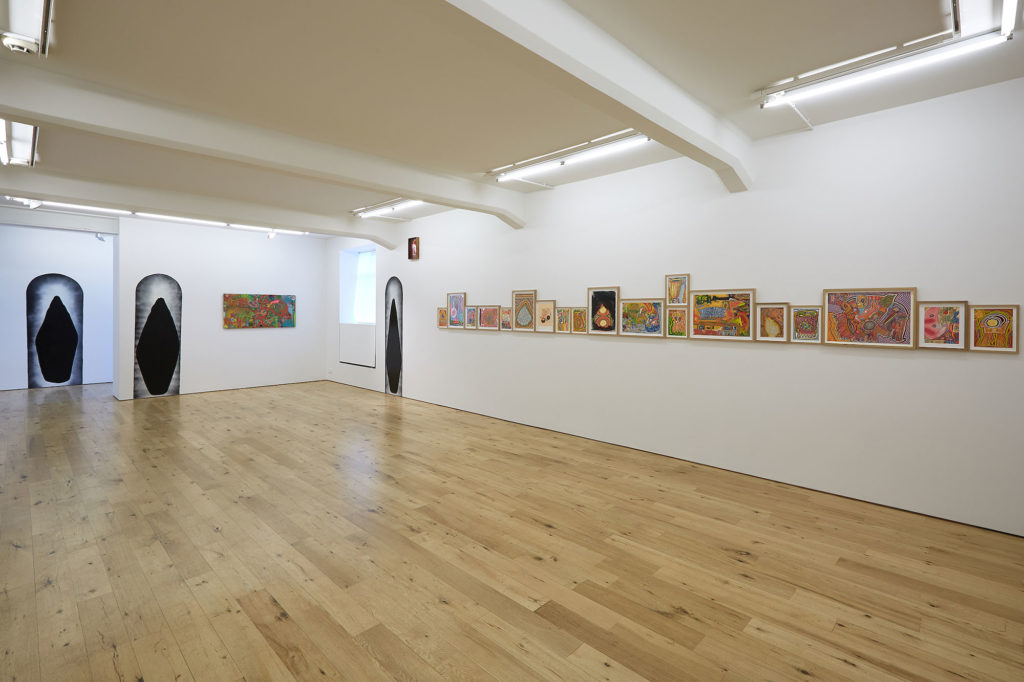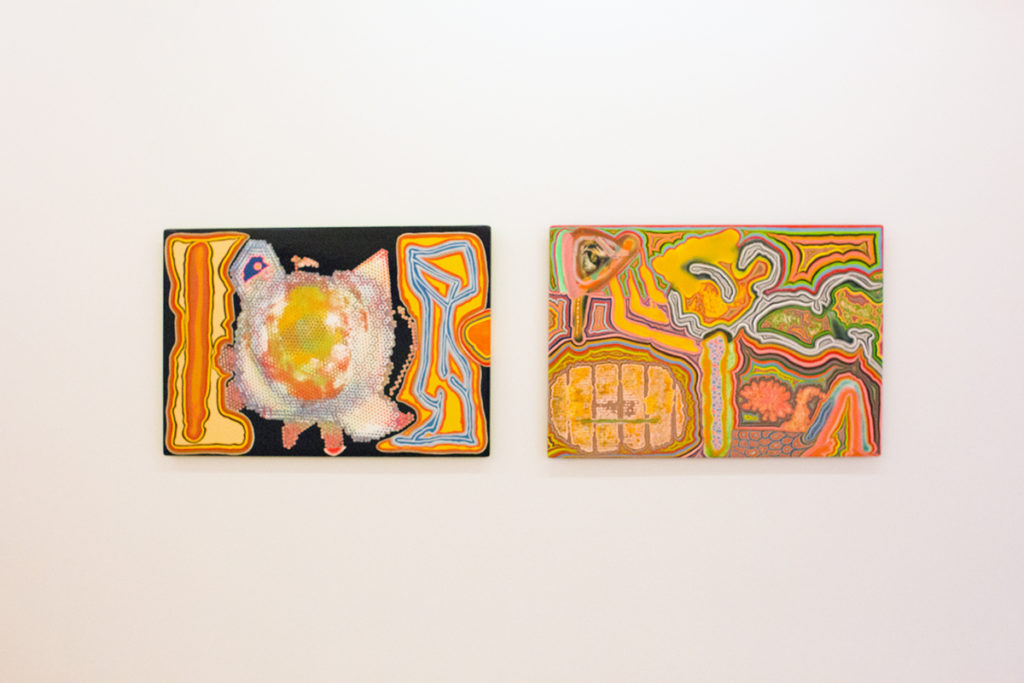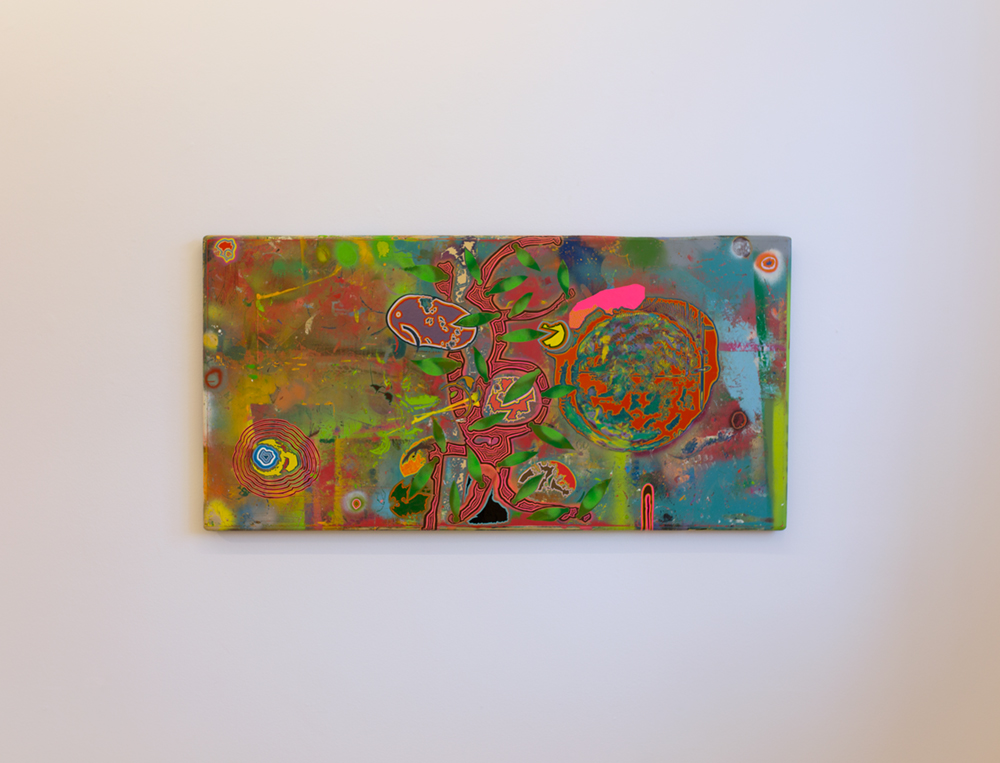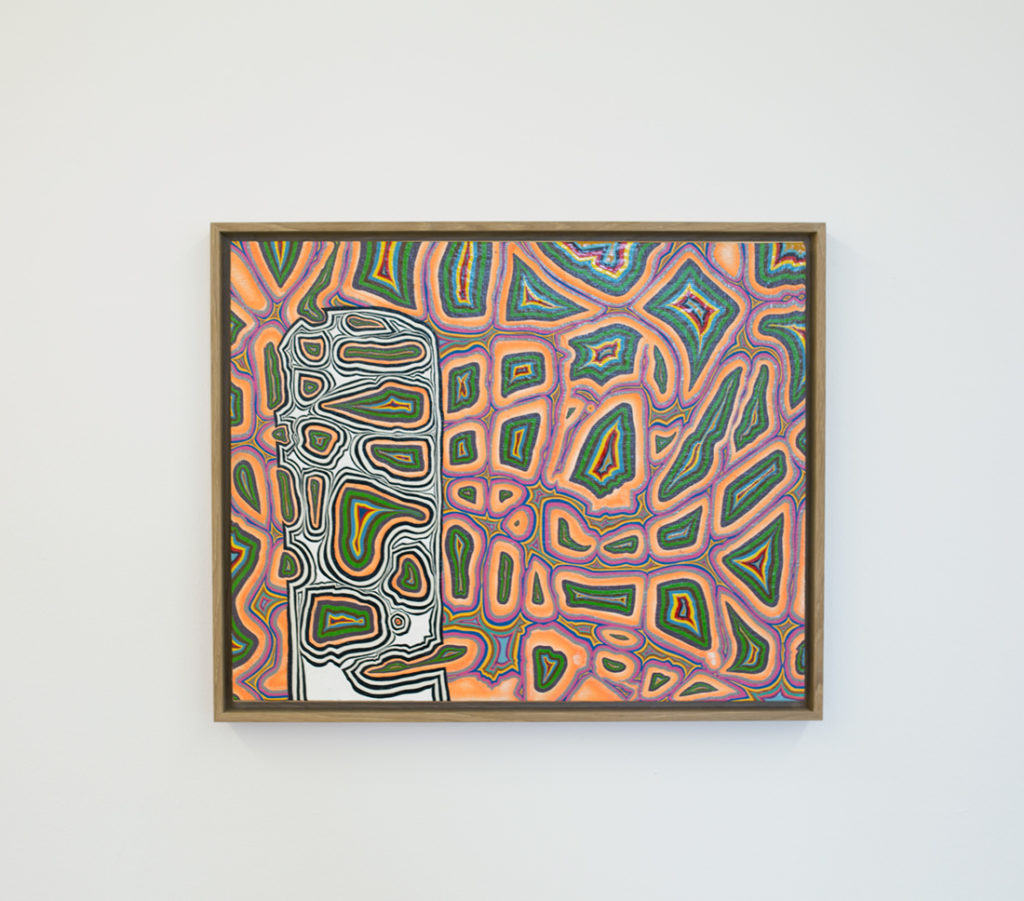
Infinite Western
Davíð Örn Halldórsson’s exhibition River únd Bátur was recently on view at Hverfisgallerí. The artist’s gesture of using found objects such as desktops, tables, and shelves for his abstract paintings calls attention to the material’s inherent aesthetic, which is transcended by the artist’s imaginative and worldly expressiveness. The effect breaks down barriers between cultures as it focuses on expressiveness and symbolism. Placed amongst the colorful worlds of his paintings, the artist has spray-painted directly onto the gallery walls a looming gray outline against which a coffin shape rests- as though he is aware of the anguish and precariousness of living.
The artist faces the precipice, taking the human predicament as the focal point instead of adhering to any formalist structures but his own. In the artist’s numerous works on paper, a visual language is formed which can be read from one frame to the next. The meaningfulness of one symbol may be disregarded in the next frame, embracing the dichotomy of meaning and interpretation. In an interview with the artist, he explains in his own weaving narration that ties many points of reference together, how everything can be meaningless as well as meaningful.
Erin: Your work appears lofty at first glance, like a fantastical world in itself, but upon inspection, it is quite taxing and heavy. There is a refreshing breath of abstraction with no signs of conceptualism- it oozes feeling and vibrancy with nothing calculated. These are my initial reactions to the paintings in the exhibition.
 Photo: Vigfús Birgisson
Photo: Vigfús Birgisson
Davíð: Actually, I’ve been thinking a lot about calculation lately and how I can paint myself into a corner. There are these structures that I have a solution for, something that I think would look good but as soon as I do it I have to redo it many times more with different colors. There is a mindlessness to the work because a decision has been made already so there is this calculated system, which is a system that is very far away from the painting in the beginning. However, I’m stuck with it so I curse myself for a few minutes and then start to work at the system. The finished thing doesn’t maybe look like it is calculated, it looks more fluid than the rigorous task that it has been, so I’m glad that it is disguised but nobody knows about it. It’s interesting to always get this reaction that my work is so free flowing.
Erin: It appears that way, very much on the surface, but I think once you sit with it longer the painting gathers weightiness.

Photo: Vigfús Birgisson
Davíð: Also, some things aren’t very rewarding because I know from the way I work I have to work over them. So all of these stripes and color pairings, when I’m painting over the whole thing that I painted, is really not a system. It’s a repetitive gesture but the reward comes much later when I haven’t seen the painting for a long time.
Erin: Your work appears as though it could be visionary as though you are expressing a visionary experience. Do you approach it more as an inner vision that is already imagined or an abstraction of all of these elements around you?
Davíð: It is of course from my experience. It’s absolutely mine so if I come back to things that I’ve maybe done before it is still always some small twists to it that I travel along in this inner vision.
Erin: Maybe the question is more about vantage points- you said you work yourself into a corner and you brush over that corner with another layer and you lose yourself there. But do you work with space consciously?

Photo: Daníel Magnússon
Davíð: The paintings are fairly clear to me when they get started although there is a lot of work to be done. If you break that down in the project I know what needs to be done far ahead and I’m always trying to catch up. So I see it clearly after I am more preliminary. What I do is- I see it clearly and after every action, there is a small tilt to the vision. Jim Henson in Fraggle Rock had these small builders that were helping the Fraggles with these ramps all over and the Fraggles broke them and ate them and they had this symbiotic relationship. They start breaking them but they needed them to break them down so they could be prepared.
Erin: You might be laughing but I think that’s a great vision of this symbiotic relationship.
Davíð: So when I am working there come these shifts and these smaller experiments within each mission that changes everything. So I have to adjust according to whatever job that pops up. It’s like the first one is free flowing ideas and the main part is just to get things going, to work and maybe the muse will visit and the next part is doing all these little jobs like a Fraggle contract worker and the other part is just finishing up and maybe being like a head of a work crew or something.
Erin: So each action creates a whole new landscape from which to venture. Are you working from the outside or the inside?
Davíð: The answer is boring because I think it’s definitely both. There are some works based on events of daily life, a person processing the daily surroundings and carrying it out in visual language but I hate it because it’s so simple and obvious to put it that way because of course, I am doing just that. It’s just so boring to try to paint what influences you especially since you are mainly creating your own language. Sometimes I get concerned about repetition but that’s just a slow reaction. It rarely happens, but I get a bit miffed when someone points it out. For this reason, perhaps, one of the characters in the absurdist play in the exhibition text is talking about how it’s all the same- pointing out the repetition.
Erin: There is something about your repetition that brings the world together with the same motifs and symbols, which I think is more helpful than anything else. Who are the most influential painters for you? Hundertwasser comes to mind, of course.

Photo: Daníel Magnússon
Davíð: Hundertwasser comes up a lot. I’ve been on pilgrimages to Vienna a few times. But he’s not important in that sense- he’s more like a cousin. There’s also Joan Miró. When you are a teenager you jump onto things like Dali and the surrealist movement and then a little later it feels a bit vapid and not as interesting as you thought to begin with. I’m always rediscovering things just by going to exhibitions. I think I really need that- to see the paintings up close to create this big enthusiasm or to make an evaluation on where this artist is in my life. I saw an exhibition of de Chirico last year, which really changed my opinion on his work. I discover things but I don’t try to find out everything about them online or something, I want it to be a bigger moment, so if I see something interesting I just keep it in the back of my mind and maybe try to look it up when I’m traveling or something. It changes so much to see the real thing- it just has another glow.
Erin: You often work with found materials like shelves and desktops. How did that process start?
Davíð: It started a bit more with me in school, not just me being broke. It started very environmentally friendly with the statement of not adding and just re-using material. I did this experiment when I was doing this movie in East Iceland on our days off where I decided to paint this mural under a bridge. I went around and asked people for leftover paint and materials. I thought it was a great concept for having their influence into the mutual paintings so it had some factor to begin with. Found materials can be so different from each other in shape and size and it keeps things interesting on some level. It also serves the purpose of not being delicate. The materials I use like spray-paint and different oils and industrials are not treated the same way inside the studio as they are when they get out. So that is just a method of working and being curious.
There is probably more outside rules to handle but with that comes also a lot of problems that I had to adjust to if there was old paint or varnish on them. The whole thing may come off when I take the paint off so I had to adjust my working methods to the materials so there is some sort of uniqueness to whatever I’m working on. There is a lot of that in this show from the same kitchen cupboards because a cousin of mine was redesigning his house and his mother had painted them all shiny white. I got them and felt bad about destroying their work but then I went to a children’s party and I saw one that had been left behind that they were still using which was big and beautiful and I just stood there stroking it during the party.
Erin: I can see how it keeps you having to continuously break out of this conventional frame. And then you have these black voids applied directly onto the walls of the exhibition. What would you call these black voids?

Photo: Vigfús Birgisson
Davíð: The found materials definitely keep things from getting monotonous in the beginning especially. Actually, I called the black voids milt myrkur or ‘mild darkness’. I do something on the walls usually but it is often more in the same vein of the paintings just on a larger scale with the same colors and maybe I’m trying to get them to speak a little bit to the paintings but I didn’t want to do that now. I wanted something to contrast the paintings.
Erin: They really balance out the other paintings.
Davíð: I wanted something to help me be expansive but still weighed down in this anchor, a druid headstone or something. I sort of worked towards it a little blindly. When I started making them in the gallery I did them first because of the fumes. I had to make a big decision about them. I didn’t get a chance to try them out because I wasn’t in my own studio, so I couldn’t do it on the wall there and it wouldn’t be the same if I did it on a plate so I just went for it in a sort of freestyle. I had this reference with the phrase milt myrkur (mild darkness) from an artist named Ernst J. Bachman who did the record sleeves for Mezzoforte in the early 80’s that are so weird. An album called Observations from my childhood was especially influential. It’s obviously just him doing experiments with airbrush and it has nothing to do with the music. The music is so upbeat, this jazz-fusion stuff and it was milt myrkur because of the music and the art. The album covers are more of an afterthought rather than being truly inspired, though.
Erin: This triangulation between the viewer, the color in your paintings, and the milt myrkur is very strong. I’m imagining a Hawkwind cover, although I’ve never seen these Mezzoforte covers. Do you listen to music while you work?
Davíð: I’m really inspired by music and have been my whole life. Music is very important but that has changed a little bit in the studio. In my old studio, I had my record player and all my music. I’ve been watching television now instead which is weird because I can’t really watch anything that is too challenging. It helps watching bad television when I am doing something monotonous like filling in color in repetitive lines. A friend gave me something when he was moving the other day, Buffy the Vampire Slayer. Lots of people have been handing me their awful DVDs, which I tend to watch more than quality films. It gives me inspiration with weird phrasing of words for titles, so if I pick something up then I write it on the wall in the studio. If it is in front of me then it stares at me from the wall while I’m working. Sometimes I put the subtitles on while I’m working. Like here, for example, I wrote in my notebook… ‘Enemy of good’. I don’t remember where that came from.
 Photo: Daníel Magnússon
Photo: Daníel Magnússon
Erin: I think there is something to that, though. There is a lot to be said for seemingly bad taste- it becomes part of a cult taste. We don’t know what compels us towards this. I had this vision in my mind that part of your work is processing the dregs of bad taste- some kind of sifting process. They still exist nonetheless- all of these cultural layers are all here. It’s so arbitrary what is considered to be good or bad. I think it’s really interesting to look at it all as one big image.
Davíð: I think for a period whenever I had an art show it was the same with every description of the art show dealing with the overflow of images. So I got very tired and bored of this quickly. Of course, it’s true like what you were saying earlier about everyone being confused about the influences of everything around them. It’s best to not complain but just to pick one thing. I pick Mezzoforte albums.
Erin: Maybe that’s the best method to get deeper into the matter.
Davíð: It’s hard to not follow trends, like mainstream advertising culture or something. A few years back I was traveling through Europe and I was also very active making art here in Iceland. Everywhere I went galleries and museums were putting up saunas like some freakish collective. Picking up your influence is sort of, talking generally, pointing out the obvious. Maybe you should just choose something; just accept it that everything is influential.
Erin: How do these black voids relate to the title of the show, River únd bátur. There was something I read about you relating the title to the notion of sinking or swimming.
Davíð: That was something I mentioned in passing, almost as a joke, in the gallery. It was quite a dark joke. The story behind it is much more me giggling with myself, just me depicting laughing at my own jokes in the studio. I’m alone in this self-made world and I’m collecting tiny objects and symbols into titles that don’t explain anything really. They are things I think are supposed to go hand in hand, although it’s not obvious on the surface. I went to the theater and saw this play and the actress was supposed to say the name of the character and I just kept hearing River únd bátur. So I was giggling in the theater at this and it just stuck. I’ve been carrying this with me for some time.
Erin: I saw some of these black voids as acting like some kind of black hole, a gateway where you could fall into or keep paddling and swimming, or, in your case, painting. The void is a source that can consume everything if you’re not continuing your action to paint. Is that far off?
Davíð: Maybe they are there in that sense. I don’t know whether I should be afraid of it or what. There is a lot of meditation and this, of course, happens so many times that you connect things with just a fragment of an idea and you are trying to grasp a work but it comes to you fairly easy without pushing it. That happens a lot and why not embrace it instead of being shy to talk about it. Maybe it’s a coincidence but it doesn’t have to be a crazy coincidence if you have all the elements and it comes together at the end. I get a little bit lost inside the studio because I have paintings all around me and titles on the walls and all these colors that you can’t see through unless you take it out of this context and let it breathe a little bit in a gallery or another place. Absolutely, it happens a lot but that is also the reason for the title. There is a vague point to be made with connecting it together and then maybe everything else sees the connection when it is given space to breathe.
Erin: The ambiguous imagery challenges how the viewer approaches a painting and in how we process visual imagery. Is it all at once in a huge impression or in these minor details? Your work seems to contain both perceptions.

Photo: Daníel Magnússon
Davíð: I’m trying to confuse with information but not let it be uncomfortable. People tend to read and write a book left to right, jumping at one symbol and then going out from there. At first glance, it probably doesn’t seem palatable, but I want it to be. I want them to make sense but that is another conflict. There can be a sensory overload in an exhibition but when you take one out of the whole thing and then put it in your living room or isolate one then it is completely different to look at it. Maybe it stands better or is easier to view, but that is sort of the struggle and that is why I wanted to make this experiment with the way I hung them. I wanted it to be a like a salon style, close together in one amorphous form. I was thinking about the colors and how to connect them all but it was too difficult to do it salon style. I decided having them down the line would be better in this context.
I used to be such an arrogant little shit. I thought you could only show a painting once- that it could only be in an exhibition once. I adjusted this thought into making every exhibition into a different book instead. The context they are in is only limited and some of them may be shown together but it’s going to be completely different. I’m so non-scientific that it’s almost ridiculous to talk about. It’s all about my aesthetic, my intuition. As for the pictures themselves, I’ve often said that the right settings about figuration give you the feeling that something just happened or something is about to happen. It gives a bit of tension that lasts like someone is about to walk into the setting or just walked out of it. The thing is that there is a teasing element because all my life I’ve gotten responses from different people that always go “it reminds me of this…” or “it looks like this…” I guess people are just trying to observe things and know how the mind works. It’s such a childish thing to observe and to talk about. The response is always a simple yes because I can’t say no. This reminds me of a snake- sure! I can’t disagree.
There is also this ethnic trend people are always comparing my work with. I don’t argue with it. It’s interesting to hear two people approach the same painting and place it on very different sides of the world- someone is talking about South America and the other one is Africa. I’m really intrigued by Aboriginal or decorative work all over the world but I haven’t really studied it in a way that I would use it, although I love it. When I recognize it, I am very intrigued by it. I was reading about Aboriginal art in Australia and I was kind of let down because that had only started in the 1960’s as a social and political expression so I had this completely different thought about how that had been perceived. I know how they use it in their religion and everything, but not how these people used it in ritual. That aspect is just weird- to hold up just one thing as art that is leftover from the religion when you are actually ignoring the way of life. So I like this decorative comparison but there is no real foundation for it and it is not delivered intentionally from me.
Erin: I think the whole notion of something native is something that is coming from an inherent-ness that has not been influenced by a wider sphere but contained in its own world. Maybe you’re native- Davíð, native painter. That’s not what I was expecting to come out, but maybe it’s not so off. You’re native to yourself, a native westerner. You’re not appropriating anything.
Davíð: It’s definitely difficult to pinpoint one thing, like naming an artist or theory or movement. Get rid of that; I’m just a native.
Erin Honeycutt
Photos: Daníel Magnússon and Vigfús Birgisson (courtesy of Hverfisgalleri).
Featured image: Daníel Magnússon.
